
Female (mature)
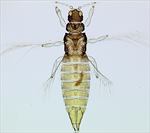
Teneral female
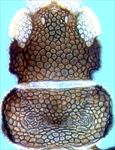
Head and pronotum

Head & thorax

Antenna
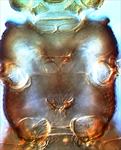
Thoracic furcae
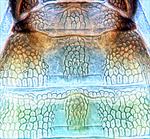
Tergites I-III

Tergites VI-X

Fore wing
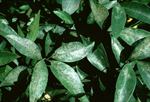
Both sexes fully winged. Body dark brown but abdomen golden in freshly emerged adults; legs yellow; antennal segments III–V & VII–VIII yellow, VI variably brown; fore wing pale with hind margin and veinal fork shaded. Antennae 8-segmented, segments III & IV each with simple sense cone, VIII slender and at least 3 times as long as VII. Head strongly reticulate, cheeks constricted into basal neck. Pronotum reticulate at anterior and posterior, with no long setae. Mesonotum reticulate at anterior. Metanotum with reticulate triangle, median setae small and arise on anterior half of sclerite. Tarsi 1-segmented. Fore wing with apex rounded bearing long cilia; costa with widely spaced long cilia, posteromarginal cilia not wavy; veinal setae scarcely larger than microtrichia. Abdominal tergites strongly reticulate on lateral thirds, II–VIII median setae long and close together; VIII with long postero-marginal comb of microtrichia; tergite X short with complete median division. Sternites with three pairs of small marginal setae.
Male very rare, except in Peru and Brazil (Mound, 1976).
Three species are recognised in the genus Heliothrips, all from South America (Nakahara et al., 2015). A further species from South Africa that was originally placed in this genus is now referred to a separate genus, Neoheliothrips.
Larvae and adults feed on the lower surface of leaves of a very wide range of trees and shrubs, including some ferns, but rarely on herbaceous plants or on plants with soft leaves (Scott-Brown & Simmonds, 2006). Large populations are particularly common on plants that are water-stressed, and leaves become mottled due to feeding damage, with their lower surface bearing characteristic black spots of larval fecal material. Pupation occurs on leaves.
Originally from South America, probably Peru (Mound, 1976), but now widespread around the world in the tropics and subtropics, also in greenhouses in temperate regions.
THRIPIDAE - PANCHAETOTHRIPINAE
Heliothrips haemorrhoidalis (Bouché)
Thrips haemorrhoidalis Bouché, 1833: 42
Heliothrips adonidum Haliday, 1836: 443
Heliothrips abdominalis Reuter, 1891: 165
Heliothrips haemorrhoidalis var. ceylonicus Schmutz, 1913: 992
Heliothrips haemorrhoidalis angustior Priesner, 1923: 89
Heliothrips semirufus Girault, 1928: 1
Dinurothrips rufiventris Girault, 1929: 1
Mound LA (1976) The identity of the greenhouse thrips Heliothrips haemorrhoidalis (Bouché) (Thysanoptera) and the taxonomic significance of spanandric males. Bulletin of Entomological Research 66: 179–180.
Nakahara S, O’Donnell CA & Mound LA (2015) Heliothrips haemorrhoidalis and its relatives, with one new species and one new genus (Thysanoptera). Zootaxa 4021 (4): 578–584.
Scott-Brown AS & Simmonds MSJ (2006) Leaf morphology of hosts and nonhosts of the thrips Heliothrips haemorrhoidalis (Bouché). Botanical Journal of the Linnean Society 152: 109–130.